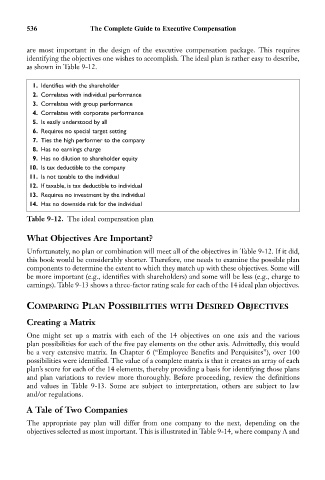Page 550 - Bruce Ellig - The Complete Guide to Executive Compensation (2007)
P. 550
536 The Complete Guide to Executive Compensation
are most important in the design of the executive compensation package. This requires
identifying the objectives one wishes to accomplish. The ideal plan is rather easy to describe,
as shown in Table 9-12.
1. Identifies with the shareholder
2. Correlates with individual performance
3. Correlates with group performance
4. Correlates with corporate performance
5. Is easily understood by all
6. Requires no special target setting
7. Ties the high performer to the company
8. Has no earnings charge
9. Has no dilution to shareholder equity
10. Is tax deductible to the company
11. Is not taxable to the individual
12. If taxable, is tax deductible to individual
13. Requires no investment by the individual
14. Has no downside risk for the individual
Table 9-12. The ideal compensation plan
What Objectives Are Important?
Unfortunately, no plan or combination will meet all of the objectives in Table 9-12. If it did,
this book would be considerably shorter. Therefore, one needs to examine the possible plan
components to determine the extent to which they match up with these objectives. Some will
be more important (e.g., identifies with shareholders) and some will be less (e.g., charge to
earnings). Table 9-13 shows a three-factor rating scale for each of the 14 ideal plan objectives.
COMPARING PLAN POSSIBILITIES WITH DESIRED OBJECTIVES
Creating a Matrix
One might set up a matrix with each of the 14 objectives on one axis and the various
plan possibilities for each of the five pay elements on the other axis. Admittedly, this would
be a very extensive matrix. In Chapter 6 (“Employee Benefits and Perquisites”), over 100
possibilities were identified. The value of a complete matrix is that it creates an array of each
plan’s score for each of the 14 elements, thereby providing a basis for identifying those plans
and plan variations to review more thoroughly. Before proceeding, review the definitions
and values in Table 9-13. Some are subject to interpretation, others are subject to law
and/or regulations.
A Tale of Two Companies
The appropriate pay plan will differ from one company to the next, depending on the
objectives selected as most important. This is illustrated in Table 9-14, where company A and

